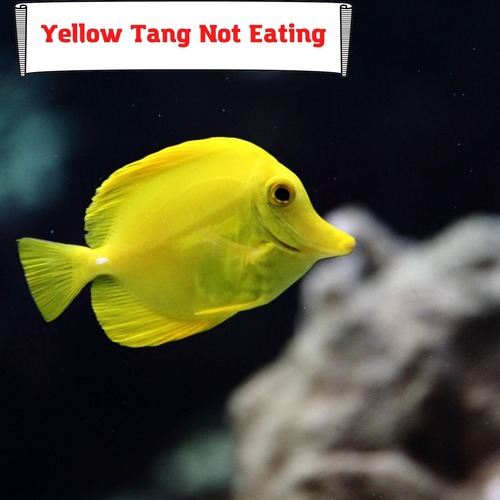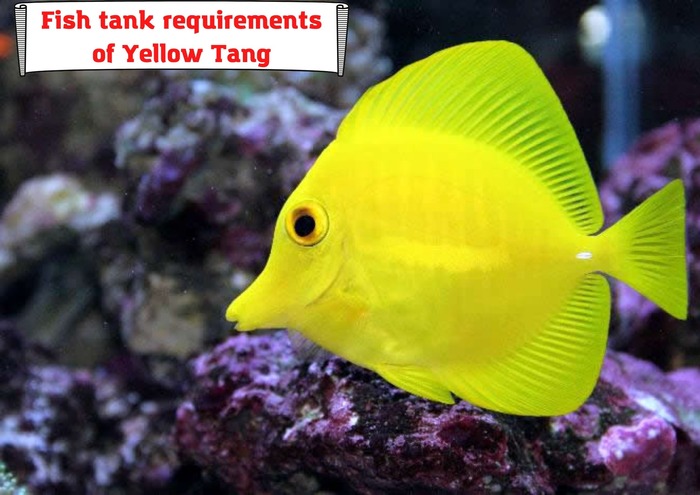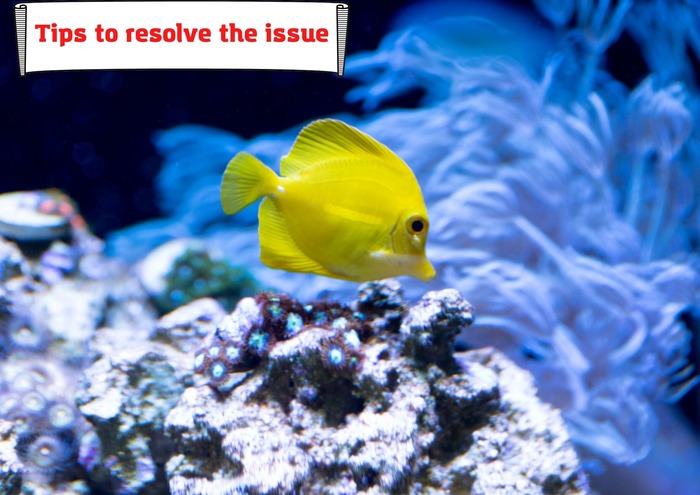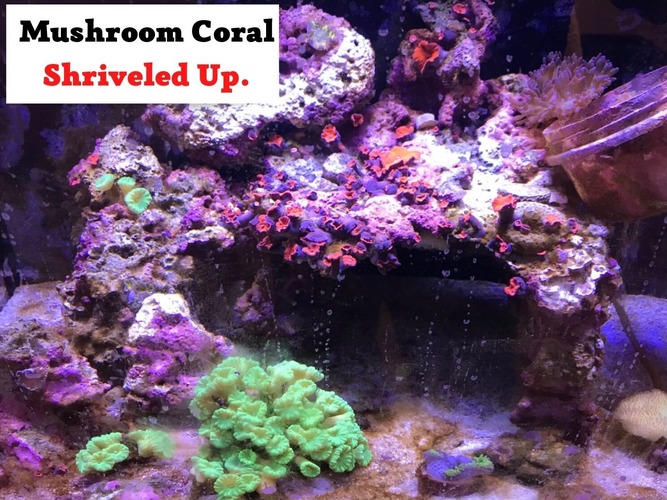
When it comes to saltwater fish, the Yellow Tang is a well-known favorite. While this fish is mainly known for its beauty, it also plays a vital role in balancing and preserving the marine ecosystem.
Color, form, personality, and maintenance simplicity are why the Yellow Tang is one of the most popular saltwater fishes. Even the most vivid reef tanks may benefit from a burst of yellow and “frenzied reef fish” movements.
This article covers:
- Biological features of Yellow Tang
- Tank requirements of Yellow Tang
- Reasons your Yellow Tang stop eating
Biological introduction of Yellow Tang
The biological name of yellow fish is Zebrasoma flavescens. Many new aquarium enthusiasts love to make it a must part of their big saltwater tanks because of their brilliant yellow hue. They’re simple to locate and reasonably priced.
It features a slim, yellow-hued, disc-shaped body with vividly colored fins, making this Surgeon member a gorgeous specimen. Yellow tangs may be aggressive, susceptible to the “ich” fish illness, and may harm coral in your reef tank. This resilient fish has a large snout-like mouth that feeds mostly on algae. As a result, their dorsal and ventral fins seem to be arrow-shaped.
The yellow Tang is a fantastic addition to a communal tank since it is normally docile. If you want to keep many tangs in the same tank, make sure it’s large enough. Adult fish may grow to 20 centimeters or 7.5 inches at full maturity. Although housed in an aquarium, their lifespan will be extended due to their sluggish development rate.
Yellow Tang color change
The fish’s bright yellow hue fades throughout the night. It gradually darkens to a grayish-brown hue. Colors revert to their normal condition during daylight hours. It is because their natural sulfur-yellow hue returns when they are active. During inactivity or when it feels threatened, the Yellow Hawaiian Tang uses its camouflage to avoid being seen by predators. A white horizontal band appears on either side after a brownish patch appears in the center of its body’s sides.
Fish tank requirements of Yellow Tang

For the sake of relaxation and play, tangs need a lot of room. Even though your yellow tangs are small, you should still maintain a big tank to accommodate their rapid growth. A tank with a capacity of more than 100 gallons is highly recommended.
Young tang fish are only around 2 to 4 inches long. They develop quickly and reach a maximum of 8 inches when completely grown. Consequently, invest in a substantial storage container.
Decorate your fish tank with aquarium plants and other items that resemble the fish’s natural environment. Your fish will benefit from the increased development of algae due to this. So these fish are lured to them to hide and rest. Live rocks might be an excellent alternative. Decorate your fish tank with aquarium plants and other items that resemble the fish’s natural environment.
Yellow tangs prefer having water in their gills. They just love it!
To maintain an oxygenated surface, a strong water flow is required. The water temperature should be approximately 75 to 82°F (24 and 28°C). The 8.0 – 8.4 pH with a specific gravity of 1.020 – 1.025 is ideal for Yellow Tang.
Feeding habits of Yellow Tang
This yellow beauty has a free nature that encourages it to move around and graze on algae outdoors and live rock algae in the aquarium if they have access to it. After acclimatization, fish can consume live and frozen meals, pellets, and other artificial fish diets. Krill, Mysis, and brine shrimp are all good choices for fish food, but flakes are also an option. Nori, Julian Sprungs, and marine vegetables are excellent choices for your yellow tangs.
Why does your Yellow Tang stop eating?
This is the question most of the YT owners often ask about. It’s important to note that your Yellow Tang may not be eating for many reasons. You have to check various conditions and reasons to reach the root cause.
The more accurately you can mimic your fish’s natural environment, the more likely they thrive. This includes good lighting, good food, and enough space to move. These are the many facets of fish farming that go into its composition.
One problem or a mix of issues is conceivable. For example, not eating due to illness or disease is the most prevalent cause of Yellow Tang mortality. Poor water quality is frequently to blame, and the shy nature of Yellow Tang is another genuine reason that your Yellow Tang has stopped eating.
Why is your Yellow Tang not eating – tips to resolve the issue

Here are five common reasons that stop your Yellow Tang from eating.
Poor water quality
Poor water quality in a fish tank is the most frequent reason Yellow Tang stops eating. It’s important to remember that fish do everything in the same water, so it’s easy for things to become icky quickly. Because ammonia is one of the chemicals in fish urine, too much of it disrupts the chemical composition of water. Fish are sensitive to pH fluctuations and water pollutants, making your Yellow Tang sick.
Bacteria and parasites grow in aquariums with poor water quality and malnourished fish. Infections may cause protruding eyes (exophthalmos), ascites (fluid buildup in the belly), or ragged unhealthy fins. These circumstances allow the bacterium to grow and cause infections in its host, ultimately killing it.
What to do?
Regularly check your fish tank water’s quality and ammonia content, and weekly water changes of 10% to 15% are advised.
Stress
Different causes of stress hinder your Yellow Tang to eat:
- Yellow Tangs are quiet at first but soon become the dominating fish in your aquarium. Sometimes when placed in their new tank, they refuse to eat. This is because the sudden shift in their surroundings stresses them. After the new aquarium resident acclimates to its new home, this natural response goes away. If they still don’t feed after a few hours, there may be a deficit in the tank. You may have chosen a species unsuitable for your environment.
- Yellow Tangs are nice alone or with other fish. It’s only feasible if you put all the fish in at once and allow them plenty of room to swim. Compatibility is also an issue that causes stress and stops fish from eating. Angelfish, puffers, clownfish, eels, hawkfish, and lionfish, among others, get along well with these fish. There may be evidence of fighting, so be on the lookout.
- Yellow Tang is very shy, and it may start to panic if they don’t have a secure spot to hide. Stressed fish are more susceptible to illness. Making your fish feel protected requires watery caverns or thick vegetation.
Diseases also stop Yellow Tang from eating
Sickness is merely an abnormal condition of the body, and illnesses don’t always indicate sickness; they mean something is wrong physically, chemically, or cognitively. Some illnesses, like ich (Ichthyophthirius multifiliis), damage the skin but may make your YT sick. Untreated ich is usually lethal. Its potential to spread is very problematic.
Different parasites such as copepods, monogeneans, and leeches can also make your Yellow Tang sick.
What to do?
Every day, inspect your fish’s general condition. If one appears sick, remove it immediately, place it in a quarantine tank, and take it to the doctor. If you don’t do this, global contagion is probable. Certain medications are diluted in water to enhance general health in an epidemic.
Water temperature can affect your Yellow Tangs appetite
It’s best to keep your tank’s water as near to natural as possible. If your YT suddenly stops eating, it’s usually because the aquarium’s temperature has fallen. They will then become dormant. Fish don’t have internal thermostats like humans. Therefore they depend on the water temperature to keep them warm.
Never let the tank’s temperature drop below 74°F (23°C) as it makes your YT sluggish and tired due to its slow metabolism. Yellow Tangs stop swimming as they casually do, and it also disturbs their eating habits badly, and this unaddressed issue leaves them starving.
Similarly, the increased water temperature disturbs the comfort level of your YT and makes them hyperactive. It may appear better than slow or drowsy, yet it is harmful. This tension might lead your aquatic buddy to stop eating.
What to do?
A frequent change of temperature and environment of your fish tank is strictly prohibited. An aquarium or fish tank is a limited and closed system with a much lesser water volume. Even a minor change in the environment responds much more rapidly to change, and your yellow beauty cannot accept this instantly.
The wrong food
Malnourished Yellow Tang stops eating, and an improved diet can quickly resolve this issue.
Yellow tangs consume algae in their natural environment, but you may feed them pellets/flakes, cooked vegetables, algae, and sometimes meat meals.
As a reward, provide blanched lettuce or spinach. It is also encouraged to feed your YT brine shrimp or bloodworms that may be frozen or live. Nori sheets are also a diet for your Yellow Tang that can be fixed to the rock or fish tank. It is the food that enhances immunity, and YT loves to chew it. Nori sheets are also helpful to reduce aggression in your YT.
Also, keep in mind that Yellow Tang can store fats, so don’t worry if it doesn’t eat for a while.
Conclusion
You can consider several aspects responsible for the appetite of your Yellow Tang. Balanced food, water quality, and water temperature are a few of the common factors to keep maintained for the better appetite of your YT.
It is always advised to create a more realistic or natural environment for your elegant YT’s proper development and good health.
- Pleco Not Eating. Main Reasons Your Pleco Is Starving - February 21, 2022
- Foxface Fish Sting: Any Danger? And What To Do To Relieve Pain? - February 20, 2022
- White Stuff Coming Out Of Snail – Dangerous? Should You Worry About It? - February 19, 2022




